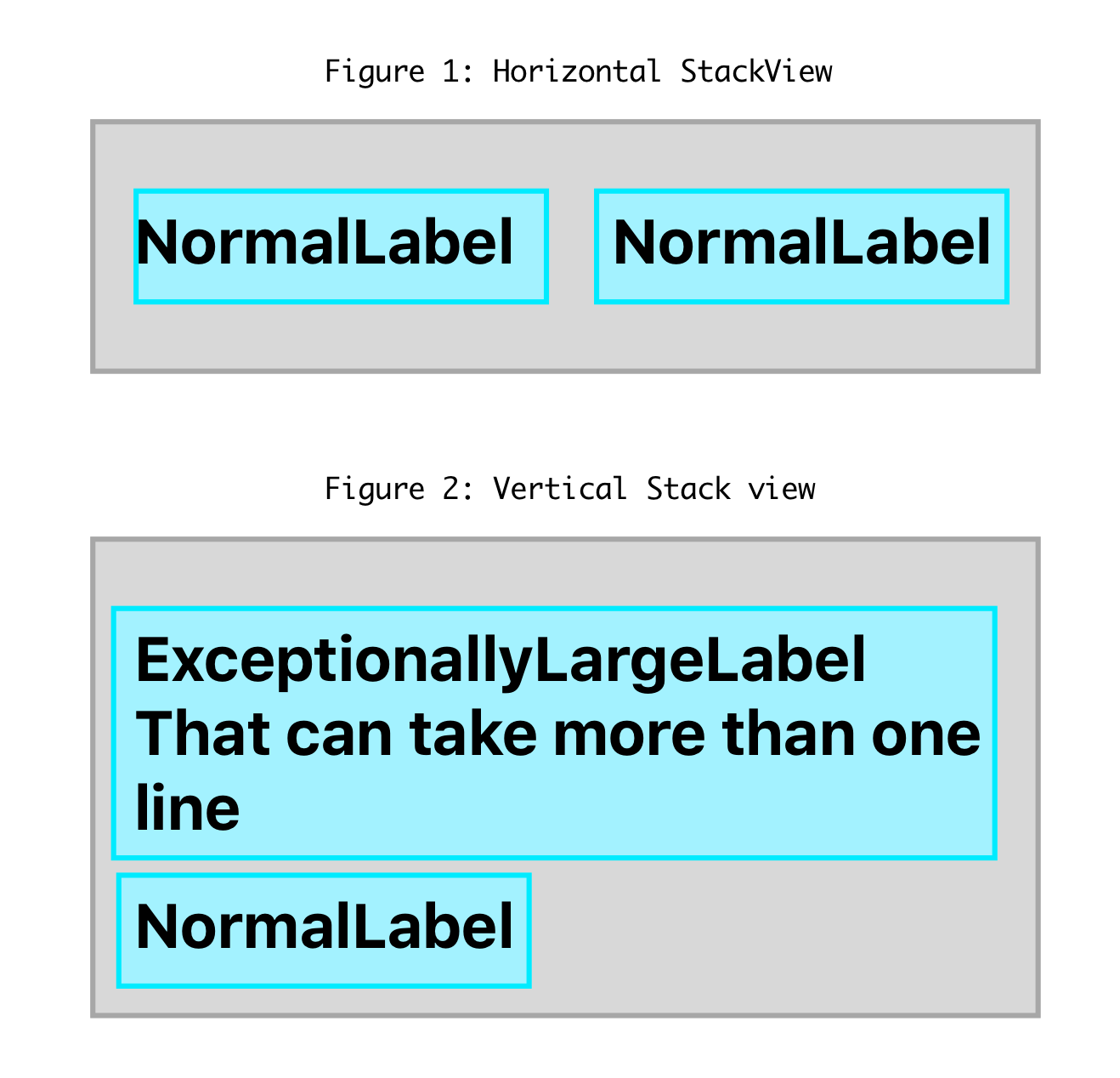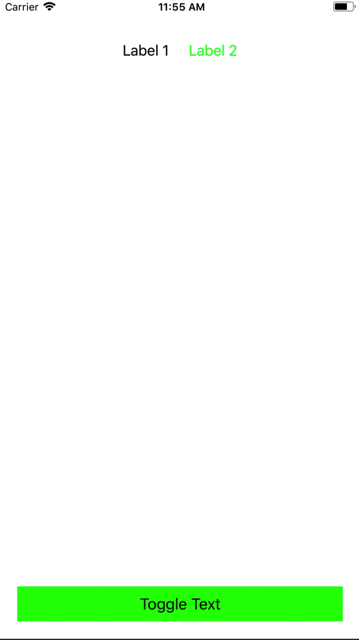Give this a go. You just have to measure the text and you have to have a stack view wrapped with another stackview.
import UIKit
class ViewController: UIViewController {
var stackView : UIStackView?
var outerStackView : UIStackView?
var label1 = UILabel()
var label2 = UILabel()
var heightAnchor : NSLayoutConstraint?
var widthAnchor : NSLayoutConstraint?
var button : UIButton?
override func viewDidLoad() {
super.viewDidLoad()
// Do any additional setup after loading the view, typically from a nib.
createStackView()
createLabelsAndAddToStack()
button = UIButton(frame: CGRect(x: 20, y: self.view.frame.height - 60, width: self.view.frame.width - 40, height: 40))
button?.backgroundColor = .green
button?.setTitleColor(.black, for: .normal)
button?.setTitle("Toggle Text", for: .normal)
button?.addTarget(self, action: #selector(toggleText), for: .touchUpInside)
button?.setTitleColor(.gray, for: .highlighted)
self.view.addSubview(button!)
}
func createStackView(){
outerStackView = UIStackView(frame: CGRect(x: 20, y: 20, width: self.view.bounds.width - 40, height: 100))
outerStackView?.axis = .vertical
outerStackView?.distribution = .fill
outerStackView?.alignment = .center
outerStackView?.translatesAutoresizingMaskIntoConstraints = false
self.view.addSubview(outerStackView!)
outerStackView?.leadingAnchor.constraint(equalTo: self.view.leadingAnchor, constant: 40).isActive = true
outerStackView?.trailingAnchor.constraint(equalTo: self.view.trailingAnchor, constant: -40).isActive = true
outerStackView?.topAnchor.constraint(equalTo: self.view.topAnchor, constant: 50).isActive = true
stackView = UIStackView(frame: CGRect(x: 20, y: 20, width: self.view.bounds.width - 40, height: 100))
stackView?.alignment = .center
stackView?.spacing = 20
stackView?.distribution = .fillEqually
stackView?.axis = .horizontal
outerStackView?.addArrangedSubview(stackView!)
heightAnchor = stackView?.heightAnchor.constraint(equalTo: outerStackView!.heightAnchor)
widthAnchor = stackView?.widthAnchor.constraint(equalTo: outerStackView!.widthAnchor)
}
func createLabelsAndAddToStack(){
label1 = UILabel(frame: .zero)
label1.textColor = .black
label1.font = UIFont.systemFont(ofSize: 17)
label1.text = "Label 1"
label1.numberOfLines = 0
stackView?.addArrangedSubview(label1)
label2 = UILabel(frame: .zero)
label2.font = UIFont.systemFont(ofSize: 17)
label2.textColor = .green
label2.text = "Label 2"
label2.numberOfLines = 0
stackView?.addArrangedSubview(label2)
}
func adaptStackView(){
self.outerStackView?.layoutIfNeeded()
self.stackView?.layoutIfNeeded()
//let maxWidth = label2.frame.width
//if you want it to be the max it could be
let maxWidth = (self.outerStackView!.frame.width - stackView!.spacing)/2
let height = label2.font.lineHeight
if let label1Text = label1.text{
//lets measure
if label1Text.width(withConstraintedHeight: height, font: label1.font) > maxWidth{
outerStackView?.axis = .horizontal
outerStackView?.distribution = .fill
stackView?.axis = .vertical
stackView?.distribution = .fill
stackView?.alignment = .leading
widthAnchor?.isActive = true
heightAnchor?.isActive = true
}else{
outerStackView?.axis = .vertical
outerStackView?.distribution = .fill
stackView?.alignment = .center
stackView?.axis = .horizontal
stackView?.distribution = .fillEqually
stackView?.removeConstraints(self.stackView!.constraints)
widthAnchor?.isActive = false
widthAnchor?.isActive = false
}
UIView.animate(withDuration: 0.5) {
self.view.layoutIfNeeded()
}
}
}
@objc func toggleText(){
if label1.text == "Label 1"{
label1.text = "This is some longer text to test everything out to see how we are doing"
}else{
label1.text = "Label 1"
}
adaptStackView()
}
}
extension String{
func width(withConstraintedHeight height: CGFloat, font: UIFont) -> CGFloat {
let constraintRect = CGSize(width: .greatestFiniteMagnitude, height: height)
let boundingBox = self.boundingRect(with: constraintRect, options: [.usesLineFragmentOrigin], attributes: [.font: font], context: nil)
return ceil(boundingBox.width)
}
}
![stackgif]()


